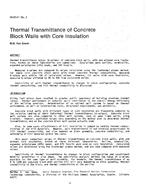Perhaps the greatest factor contributing since the turn of the Century to rapid industrial growth and high standard of living in the U.S. has been the availability of abundant low cost energy. Consumption of energy has been enormous, and future requirements will continue to be immense. In fact, it has been predicted that usage will double each decade, but we no longer can afford the inefficient waste of our energy resources.
Conservation is now an integral part of good planning, for efficiency of usage, and is being recognized as economically and technically feasible. Energy conservation may therefore soon become compulsory. The number of possible ways to increase efficient energy use, and the number of papers on the subject, are equally large. Some proposals start at the well head or mine shaft, others are basic–like setting back the thermostat at night or turning off lights when leaving a room; others again recommend techniques of great sophistication. This paper discusses one important area: how to realize appreciable savings in heating and cooling equipment, fuel, maintenance, and other operating costs by recovering energy from exhaust air before it is thrown away.
Citation: Symposium, ASHRAE Transactions, Volume 80, Part 1, Los Angeles, CA
Product Details
- Published:
- 1974
- Number of Pages:
- 8
- File Size:
- 1 file , 1 MB
- Product Code(s):
- D-LA-74-05-2


